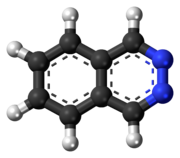
| |

| |
| Names | |
|---|---|
| Preferred IUPAC name
Phthalazine[2] | |
| Other names
Benzo-orthodiazine
2,3-Benzodiazine Benzo[d]pyridazine | |
| Identifiers | |
3D model (JSmol)
|
|
| ChemSpider | |
| ECHA InfoCard | 100.005.422 |
PubChem CID
|
|
| UNII | |
CompTox Dashboard (EPA)
|
|
| |
| |
| Properties | |
| C8H6N2 | |
| Molar mass | 130.150 g·mol−1 |
| Appearance | Pale yellow needles |
| Melting point | 90 to 91 °C (194 to 196 °F; 363 to 364 K) |
| Boiling point | 315 to 317 °C (599 to 603 °F; 588 to 590 K) (decomposition) |
| Miscible | |
| Acidity (pKa) | 3.39[3] |
Except where otherwise noted, data are given for materials in their standard state (at 25 °C [77 °F], 100 kPa).
| |
Phthalazine, also called benzo-orthodiazine or benzopyridazine, is a heterocyclic organic compound with the molecular formula C8H6N2. It is isomeric with other naphthyridines including quinoxaline, cinnoline and quinazoline.
- ^ Merck Index, 11th Edition, 7344.
- ^ Nomenclature of Organic Chemistry : IUPAC Recommendations and Preferred Names 2013 (Blue Book). Cambridge: The Royal Society of Chemistry. 2014. p. 212. doi:10.1039/9781849733069-FP001. ISBN 978-0-85404-182-4.
- ^ Brown, H.C., et al., in Baude, E.A. and Nachod, F.C., Determination of Organic Structures by Physical Methods, Academic Press, New York, 1955.